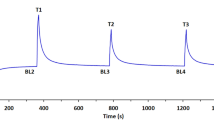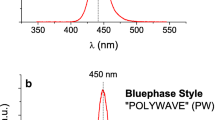Abstract
The objective of this study was to investigate the effect of exposure time on color stability of resin-based restorative materials when polymerized with quartz–tungsten halogen light (QTH) or light-emitting diode light (LED). Eight samples of Ceram-X Mono, Dyract eXtra, and Tetric EvoCeram each were cured for 10, 20, and 60 s with QTH or LED. The CIE-Lab values (L*, a*, b*) were measured prior to and after performing water storage or a Suntest, and ΔL, Δa, Δb, and ΔE were calculated. Statistical analysis (p < 0.05) showed significant changes of the color values after each of the aging processes as well as between ΔL, Δa, Δb, and ΔE of the materials in dependence of the curing device, exposure time, aging condition, and material formulation. LED performed similarly or even better with 10-s exposure time than QTH with 20 s. No improvement of color stability was achieved with increasing exposure time of 60 s either for LED or for QTH. Exposure time, emission spectrum of the light-curing device, as well as the individual material formulation influence color stability. There is apparently an exposure time above which the individual material formulation, especially type and amount of photoinitiator or synergist, dominate the color stability.

Similar content being viewed by others
References
Mobarak E, Elsayad I, Ibrahim M, El-Badrawy W (2009) Effect of LED light-curing on the relative hardness of tooth-colored restorative materials. Oper Dent 34:65–71
Fleming GJ, Khan S, Afzal O, Palin WM, Burke FJ (2007) Investigation of polymerisation shrinkage strain, associated cuspal movement and microleakage of MOD cavities restored incrementally with resin-based composite using an LED light curing unit. J Dent 35:97–103
Campregher UB, Samuel SM, Fortes CB, Medina AD, Collares FM, Ogliari FA (2007) Effectiveness of second-generation light-emitting diode (LED) light curing units. J Contemp Dent Pract 8:35–42
Schneider LF, Consani S, Correr-Sobrinho L, Correr AB, Sinhoreti MA (2006) Halogen and LED light curing of composite: temperature increase and Knoop hardness. Clin Oral Investig 10:66–71
Ramp LC, Broome JC, Ramp MH (2006) Hardness and wear resistance of two resin composites cured with equivalent radiant exposure from a low irradiance LED and QTH light-curing units. Am J Dent 19:31–36
Martinelli J, Pires-de-Souza Fde C, Casemiro LA, Tirapelli C, Panzer H (2006) Abrasion resistance of composites polymerized by light-emitting diodes (LED) and halogen light-curing units. Braz Dent J 17:29–33
Hasler C, Zimmerli B, Lussi A (2006) Curing capability of halogen and LED light curing units in deep class II cavities in extracted human molars. Oper Dent 31:354–363
Vandewalle KS, Roberts HW, Andrus JL, Dunn WJ (2005) Effect of light dispersion of LED curing lights on resin composite polymerization. J Esthet Restor Dent 17:244–254 discussion 254–255
Correr AB, Sinhoreti MA, Correr Sobrinho L, Tango RN, Schneider LF, Consani S (2005) Effect of the increase of energy density on knoop hardness of dental composites light-cured by conventional QTH, LED and xenon plasma arc. Braz Dent J 16:218–224
Janda R, Roulet JF, Latta M, Kaminsky M, Ruttermann S (2006) Effect of exponential polymerization on color stability of resin-based filling materials. Dent Mater 23:696–704
Ruttermann S, Servos A, Raab WH, Janda R (2008) In vitro effect of light-emitting diode light polymerization on the color stability of three resin-based restorative materials. Acta Odontol Scand 66:43–49
Janda R, Roulet J-F, Latta M, Steffin G, Rüttermann S (2005) Color stability of resin based filling materials after aging when cured with plasma or halogen light. Eur J Oral Sci 113:251–257
Janda R, Roulet JF, Kaminsky M, Steffin G, Latta M (2004) Color stability of resin matrix restorative materials as a function of the method of light activation. Eur J Oral Sci 112:280–285
Ruyter IE, Oysaed H (1982) Conversion in different depths of ultraviolet and visible light activated composite materials. Acta Odontol Scand 40:179–192
Sarafianou A, Iosifidou S, Papadopoulos T, Eliades G (2007) Color stability and degree of cure of direct composite restoratives after accelerated aging. Oper Dent 32:406–411
Zamarripa E, Ancona AL, D’Accorso NB, Macchi RL, Abate PF (2008) Effect of energy density on color stability in dental resin composites under accelerated aging. Acta Odontol Latinoam 21:11–15
Yazici AR, Celik C, Dayangac B, Ozgunaltay G (2007) The effect of curing units and staining solutions on the color stability of resin composites. Oper Dent 32:616–622
EN ISO 7491 (2001) Dental materials—determination of colour stability
EN ISO 4049 (2000) Dentistry—polymer-based filling, restorative and luting materials
Tanoue N, Koishi Y, Yanagida H, Atsuta M, Shimada K, Matsumura H (2004) Color stability of acrylic resin adhesives with different initiation modes. Dent Mater J 23:368–372
Pires-de-Souza Fde C, Garcia Lda F, Hamida HM, Casemiro LA (2007) Color stability of composites subjected to accelerated aging after curing using either a halogen or a light emitting diode source. Braz Dent J 18:119–123
Ertas E, Guler AU, Yucel AC, Koprulu H, Guler E (2006) Color stability of resin composites after immersion in different drinks. Dent Mater J 25:371–376
Janda R (1987) Synthetic resins. Ullmann*s encyclopedia of industrial chemistry, vol 8, 5th edn, Chapter 5, Dental materials. VCH, Weinheim, pp 277–284
Uhl A, Mills RW, Jandt KD (2003) Photoinitiator dependent composite depth of cure and Knoop hardness with halogen and LED light curing units. Biomaterials 24:1787–1795
Ameye C, Lambrechts P, Vanherle G (1981) Conventional and microfilled composite resins. Color stability and marginal adaption. J Prosthet Dent 46:623–630
Söderholm KJM (1983) Leaking of fillers in dental composites. J Dent Res 62:126–130
Shin DH, Rawls HR (2009) Degree of conversion and color stability of the light curing resin with new photoinitiator systems. Dent Mater 25:1030–1038. http://www.ncbi.nlm.nih.gov/entrez/query.fcgi?cmd=Retrieve&db=PubMed&dopt=Citation&list_uids=19371946
Schneider LF, Cavalcante LM, Consani S, Ferracane JL (2009) Effect of co-initiator ratio on the polymer properties of experimental resin composites formulated with camphorquinone and phenyl-propanedione. Dent Mater 25:369–375
Ogunyinka A, Palin WM, Shortall AC, Marquis PM (2007) Photoinitiation chemistry affects light transmission and degree of conversion of curing experimental dental resin composites. Dent Mater 23:807–813
Park YJ, Chae KH, Rawls HR (1999) Development of a new photoinitiation system for dental light-cure composite resins. Dent Mater 15:120–127
Dyract eXtra (2003) Scientific compendium, DeTrey Dentsply GmbH, Constance, Germany
Yap AU, Wang X, Wu X, Chung SM (2004) Comparative hardness and modulus of tooth-colored restoratives: a depth-sensing microindentation study. Biomaterials 25:2179–2185
Material Safety Data Sheet Tetric EvoCeram (2004) Ivoclar Vivadent Inc., Amherst, NY, USA
Scientific Documentation TetricEvoCeram (2005) Ivoclar Vivadent AG, Schaan, Liechtenstein
Conflict of interest
The authors declare that they have no conflict of interest.
Author information
Authors and Affiliations
Corresponding author
Additional information
Results are part of the thesis of Suyoun Kim.
Rights and permissions
About this article
Cite this article
Rüttermann, S., Suyoun, K., Raab, W.HM. et al. Effect of exposure time on the color stability of resin-based restorative materials when polymerized with quartz–tungsten halogen and LED light. Clin Oral Invest 14, 599–605 (2010). https://doi.org/10.1007/s00784-009-0316-y
Received:
Accepted:
Published:
Issue Date:
DOI: https://doi.org/10.1007/s00784-009-0316-y




